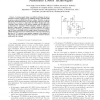Free Online Productivity Tools
i2Speak
i2Symbol
i2OCR
iTex2Img
iWeb2Print
iWeb2Shot
i2Type
iPdf2Split
iPdf2Merge
i2Bopomofo
i2Arabic
i2Style
i2Image
i2PDF
iLatex2Rtf
Sci2ools
94
Voted
SOCC
2008
IEEE
2008
IEEE
A subthreshold single ended I/O SRAM cell design for nanometer CMOS technologies
— Lowering supply voltage is an effective technique for power reduction in memory design, however traditional memory cell design fails to operate, as shown in [3], [10], at ultra-low voltages. Therefore, to operate cells in the subthreshold regime, new cell structures needs to be explored. Towards this, we present a single-ended I/O (SEIO) bit-line latch style 7-transistor static random access memory (SRAM) cell (7T-LSRAM) as an alternative for nanometer CMOS technology which can function in ultra-low voltage regime. Compared to existing 6-transistor (6T) cell or 10-transistor cell design, the proposed cell has 2X improved read stability and ¿ ± better write-ability at lower supply voltage. Furthermore, the 7TLSRAM has improved process variation tolerance. The area analysis shows that there is ½ ± increase in area penalty compared to the standard 6T cell, however the improved performance and process variation tolerance could justify the overhead.
Cell | Cell Design | Education | SOCC 2008 | Ultra-low Voltage |
| Added | 01 Jun 2010 |
| Updated | 01 Jun 2010 |
| Type | Conference |
| Year | 2008 |
| Where | SOCC |
| Authors | Jawar Singh, Jimson Mathew, Dhiraj K. Pradhan, Saraju P. Mohanty |
Comments (0)

